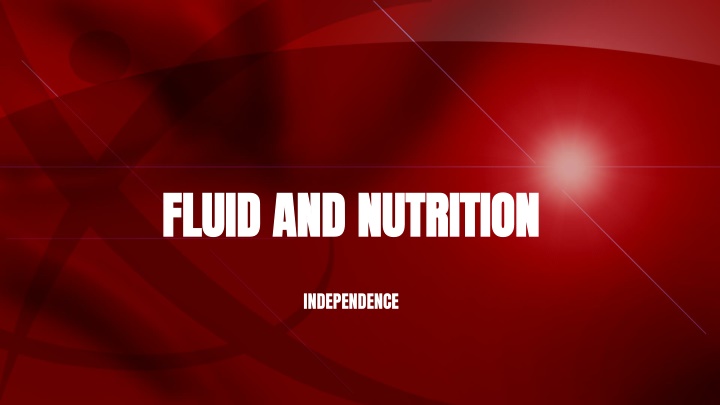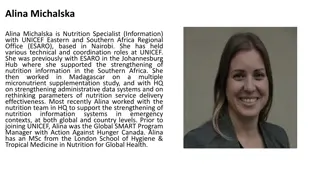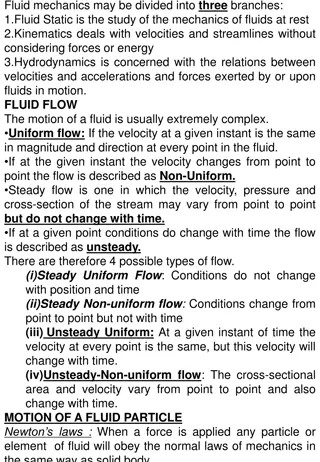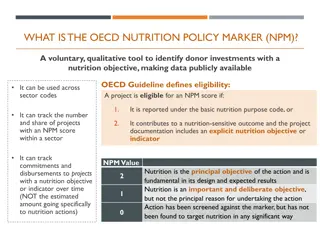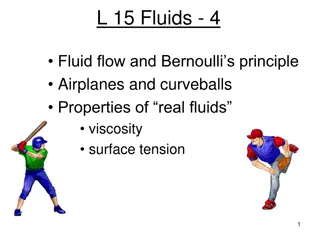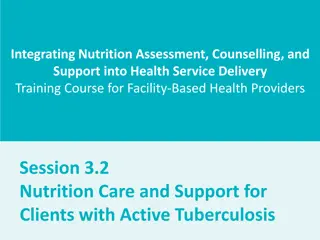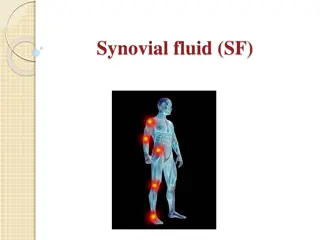Fluid and Nutrition Independence
Achieve independence in your journey to optimal health by understanding the importance of proper fluid intake and nutrition. Discover how these elements work together to support your body's functions and maintain overall well-being. Empower yourself with knowledge and practical tips to take control of your health through mindful choices and balanced lifestyle habits.
Download Presentation

Please find below an Image/Link to download the presentation.
The content on the website is provided AS IS for your information and personal use only. It may not be sold, licensed, or shared on other websites without obtaining consent from the author.If you encounter any issues during the download, it is possible that the publisher has removed the file from their server.
You are allowed to download the files provided on this website for personal or commercial use, subject to the condition that they are used lawfully. All files are the property of their respective owners.
The content on the website is provided AS IS for your information and personal use only. It may not be sold, licensed, or shared on other websites without obtaining consent from the author.
E N D
Presentation Transcript
FLUID AND NUTRITION FLUID AND NUTRITION INDEPENDENCE
FLUID AND NUTRITION NORMAL DIETARY REQUIREMENT: Nutrition Defined: The processes by which the body takes in food and uses it for growth, repair, and maintenance of good health. Those who are ill or elderly, a well-balanced nutritious diet helps maintain muscle and skin tissues and prevent pressure sores. A good diet helps heal wounds more quickly and improves the ability to deal with physical and emotional stress. Nutrition is obtained through the intake of a health diet. Healthy snacks are also important for good nutrition. Fresh vegetables and nuts are examples. Dietary Guidelines describe a healthy diet as one that: -Emphasizes fruits, vegetables, whole grains, and fat-free or low-fat milk and milk products -Includes lean meats, poultry, fish, beans, eggs, and nuts. -Is low in saturated fats, trans fats, cholesterol, salt (sodium), and added sugars.
FLUID AND NUTRITION NORMAL DIETARY REQUIREMENT: Body uses essential nutrients in food to supply heat and energy, to build or repair tissue, and to regulate body functions. Six Essential nutrients required by the body which are found in a variety of foods: Protein Build and repair body tissue; provide heat and energy. Fish, seafood, poultry, eggs, meat, mild, cheese, nuts, peas, dried beans, legumes Carbohydrates Fuel for heat and energy, help the body use fat, a source of fiber Sugar, syrups, jellies, sweets, bread, cereal, potatoes, rice, pasta, fruits and vegetables Fats Provide fatty acids needed for growth and development; provide heat and energy Fat-marbled meat, butter, cheese, nuts, oils Vitamins: A, B-complex, C, D, E, K Vitamins regulate body processes and functioning. Found in a variety of foods Minerals: calcium, potassium, iodine, iron, copper phosphorus Build body tissues such as bones and teeth Found in a variety of foods Water: 50-60% of body weight Carries nutrients and wastes to/from body cells; regulates body functions; essential to life and all body system functioning. Tap water, bottled water. Normal adult intake is 2 quarts per day.
FLUID AND NUTRITION NORMAL DIETARY REQUIREMENT: Proteins and Carbohydrates: Proteins: Proteins are part of every body cell. Necessary for tissue growth and repair. Serve as a source of energy and help us to fight against disease. When we eat more proteins than our bodies need, the proteins are stored as body fat or are sent out of the body by our kidneys. Sources for protein include: -Fish and seafood -Poultry, eggs, and milk -Nuts, peas, and dried beans or legumes Continued
FLUID AND NUTRITION NORMAL DIETARY REQUIREMENT: Continued: Carbohydrates: Supply the fuel for the body s energy needs. Help body to use fat efficiently and some carbohydrate sources also supply extra protein. They are broken down into sugars during the digestive process and are absorbed into the blood Provide fiber to help in bowel elimination (stools). Sources for Carbohydrates include: -Bread and cereal -Potatoes, rice and pasta -Fruits and vegetables Sugar, syrups, and jellies and other such sweet foods also provide carbohydrates but are not the best source and may result in excessive calories.
FLUID AND NUTRITION NORMAL DIETARY REQUIREMENT: Fats: Fats produce heat and energy to the body. Fat functions in the following ways. Provides the body with insulation Protects the body organs Supplies essential fatty acids necessary for healthy nerve tissue Adds flavor to foods Aides in absorption of certain vitamins Excess fat is stored as fat in the body and leads to obesity. Fats are found primarily in animal foods but also in some plant foods. Foods that are a major or high source of fat include: -Fat-marbled meat (meat with fat throughout the meat) and bacon -Butter -Nuts -Oils
FLUID AND NUTRITION NORMAL DIETARY REQUIREMENT: Vitamins and Minerals: Vitamins regulate body processes and functioning. Vitamins cannot be produced by the body and therefore need to be obtained through food or vitamin supplements. Minerals Assist with various chemical reactions within the body. Examples of minerals include zinc, iron, calcium and magnesium. Minerals help build body tissues such as bones and teeth, as well as help the body use other essential nutrients.
FLUID AND NUTRITION NORMAL DIETARY REQUIREMENT: Vitamins and Minerals: Lack of Vitamins: Vitamin A, B1, and B2: will feel tired and have loss of appetite. Vitamin A: Night blindness, xerophthalmia Vitamin B2: Problems with lips, tongue, skin Vitamin B12: Pernicious anemia Vitamin D: Rickets Vitamin E: Malabsorption of fats, anemia Vitamin K: Poor blood clotting, internal bleeding Lack of Minerals: Calcium: Strengthens teeth and bones Fluoride: Strengthens teeth Iodine: Combines with tryosine to create the hormone thyroxine Iron: Transports oxygen in red blood cells Potassium: Important ion in nerve cells
FLUID AND NUTRITION NORMAL DIETARY REQUIREMENT: Water: One of the most important nutrients for life. 50-60% of our body weight comes from water. Important to drink 6 to 8 glasses of water (2 quarts) a day to maintain the right amount of water in the body. Water works in the body in the following ways: Assists in digestion. Helps in absorption of food. Aids in elimination of waste Maintains body temperature through perspiration (sweating). Keeps the body in fluid balance (the right amount of fluid within the circulatory system so that the patient is neither dehydrated nor has excessive fluid in the system). Water can be found in: Tap water or bottled water Juice, soda, tea Milk Celery and lettuce Apples, melons and peaches Meat, chicken and fish
FLUID AND NUTRITION USDA Food Guide: Contains 5 different colored sections on the plate and cup for the different food groups Organs for grains Purple for protein Green for vegetables Red for fruits Blue for milk. The section size shows how much of each type of food to eat. The section size shows how much of each type of food to eat. USDA Food Guide: Contains 5 different colored sections on the plate and cup for the different food groups Organs for grains Purple for protein Green for vegetables Red for fruits Blue for milk. www.choosemyplate.gov Website provides information on the daily servings recommended for a Balance, healthy diet for a variety of people and ages. The foundation for a balanced diet for most people should include: A variety of foods Lots of fruits, vegetables and whole grains (bread, cereal and whole-grain pasta). Food choices low in saturated fat and cholesterol (lean meats, fish, poultry, low-fat milk). Limited amounts of sugar and salt. At least 6 to 8 glasses of water every day. At least 6 to 8 glasses of water every day. www.choosemyplate.gov Website provides information on the daily servings recommended for a Balance, healthy diet for a variety of people and ages. The foundation for a balanced diet for most people should include: A variety of foods Lots of fruits, vegetables and whole grains (bread, cereal and whole-grain pasta). Food choices low in saturated fat and cholesterol (lean meats, fish, poultry, low-fat milk). Limited amounts of sugar and salt. People with health problems should consult their doctor for specific instructions related to their daily diet. diet. People with health problems should consult their doctor for specific instructions related to their daily
FLUID AND NUTRITION Healthy Living: The Food and Drug Administration Modernization Act and the Dietary Guidelines for Americans, 2005, provide the following recommendations for the general public. 1. Adequate Nutrients Within Calorie Needs - Consume a variety of foods and beverages that are rich in nutrients. Include all of the basic food groups and limit the intake of saturated and trans fats, cholesterol, added sugars, salt, and alcohol. 2. Weight Management - To maintain body weight in a healthy range, balance calories from foods and beverages with calories you burn through physical activity. - To prevent gradual weight gain over time, make small decreases in food and beverage calories and increase physical activity. 3. Physical Activity - Engage in regular physical activity and reduce inactivity to promote health, psychological well-being, and a healthy body weight. - Try to be physically active at least 30 minutes on most days of the week or break the session down into two 15-minute sessions or three 10-minutes sessions depending on your time and ability. - Greater health benefits can be obtained by engaging in physical activity that is more intense or for longer than 30 minutes. CONTINUED
FLUID AND NUTRITION Continued for Healthy Living: 4. Food Groups To Encourage Eat plenty of fruits and vegetables- 2 cups of fruit and 21/2 cups of vegetables per day as a general rule of thumb. Choose a variety of fruits and vegetables each day. 5. Fats read labels carefully Eat less than 10 percent of calories from saturated fatty acids. And less than 300 mg/day of cholesterol and keep trans fatty acid consumption as low as possible. Keep total fat intake between 20-35 percent of calories. 6. Carbohydrates Choose high-fiber fruits, vegetables, and whole grains often. Stay away from prepared foods and beverages with lots of added sugars. 7. Sodium and Potassium read labels carefully Consume less than 2,300mg (approximately 1 teaspoon of salt) of sodium per day. Choose and prepare foods with little salt. Eat potassium-rich foods, such as fruits and vegetables. CONTINUED
FLUID AND NUTRITION Continued for Healthy Living: 7. Sodium and Potassium read labels carefully Consume less than 2,300mg (approximately 1 teaspoon of salt) of sodium per day. Choose and prepare foods with little salt. Eat potassium-rich foods, such as fruits and vegetables. 8. Alcoholic Beverages Those who choose to drink alcoholic beverages should do so sensibly and in moderation- one drink per day for women and up to two drinks per day for men. Never mix medications with alcohol without discussing it with your doctor.
FLUID AND NUTRITION NORMAL DIETARY REQUIREMENT: Signs of Good Nutrition: Signs of a person with good nutrition include: Alert expression Clear eyes Healthy skin Shiny, healthy hair Strong, healthy nails Normal urination and bowel movements Healthy sleep patterns Pleasant attitude Appropriate appetite
FLUID AND NUTRITION NORMAL DIETARY REQUIREMENT: Meeting Nutrition Needs: Nutritional needs of the elderly are the same as those of a young adult. Becomes more difficult for the elderly, illness, or disability persons to meet their nutritional needs due physical and psycho-social factors. Aide plays an important role in helping the patient, regardless of the age or illness, meet these needs.
FLUID AND NUTRITION MEAL PREP COOKING General Health: The general health and well-being of the elderly person significantly influences his or her nutritional intake. For example, a person: Who is tired may not have the energy to eat and/or drink. Who is forgetful or otherwise not mentally alert may forget about mealtime or forget whether or not he or she has eaten or drank. With an illness, infection or disease may not feel well enough to eat or drink. Direct support caregiver may: Check with the nurse to see if there is something you should be doing to encourage the client to get more rest and sleep. Remind the client to eat. If client does not have someone to prepare the meal or remind him or her to eat, it may be part of the plan of care to prepare and serve the meal. It may be helpful to remind the client ahead of time that mealtime is approaching.
FLUID AND NUTRITION MEAL PREP COOKING Sensory Loss: The senses include the sense of hearing, smell, taste, touch, sight and hearing. There is some loss of sensory ability that is a natural part of aging, especially taste, smell and sight. AS the senses decrease, the desire for food may decrease. Smell influences your hunger and your desire to eat. When sense of smell decreases, motivation to eat may not be present. The result may be a decrease in appetite. If the sense of taste is decreased or absent, the motivation to eat is also decreased. A decrease in the senses of taste and smell begins around age 60 and is more pronounced by age 70. The tongue s taste buds become less sensitive, and the nerves in the nose that register aromas need extra stimulation to detect mouth-watering smells. Tastes and smells are important because they bring pleasure and enjoyment to eating, which can improve the desire to eat. Which can help maintain a healthy weight and immune system, which will improve overall health. Vision and hearing losses affect nutrition in other ways.
FLUID AND NUTRITION MEAL PREP COOKING Change in Taste Related to Medications: Foods may have no flavor or tastes bad because of certain medication the client is taking. Sometimes medications can be changed so that they have less of an effect on taste. Notify the nurse if a client repeatedly tells you that food has no taste or that it taste bad. When considering flavor enrichment for older adults, keep individual food preferences and allergies or sensitivities in mind. With an abundance of spices, herbs and food ingredients, it is possible to enhance flavor while addressing individual choices, preferences, and medical needs.
FLUID AND NUTRITION MEAL PREP COOKING Increasing Flavor of Food: Adding more flavor to food may increase the appetite. Tips to increase the flavor of foods include: Double the amount of flavorings called for in recipes or add flavoring even when it s not called for. However, if patient is on a salt restricted diet, the salt should be limited to no more than the amount listed on the recipe. Add maple extract in cookies, lemon flavoring in pudding, etc. Pep up dishes by adding chopped onion or garlic. Add fresh or dried herbs to vegetables. Sprinkle on a little cheese, bacon, or butter flavoring. Add fruit to meat as it cooks to add texture and flavor. Add texture by using crunchy foods. Use nectars and jams to make intensely flavored sauces. Combine foods with different temperatures to add a variety of taste sensations.
FLUID AND NUTRITION MEAL PREP COOKING Physical Comfort: Try to find out if there are specific foods that are problematic for your patient. Discuss alternative foods with your nursing supervisor or dietary personnel.
FLUID AND NUTRITION MEAL PREP COOKING Increasing Physical Comfort: In addition to avoiding foods that cause problems for a client, there are other strategies to use to increase the physical comfort of the client, such as: Making sure the client is in a comfortable position for mealtime. Making sure the client can reach food without a lot of effort or pain. Offering the client, a sweater or lap robe if he or she is cold. Positioning the client in a chair or bed so that it is easy to swallow and to prevent choking back straight, head elevated, arms resting comfortably. Making sure the room is a comfortable temperature and is well lit.
FLUID AND NUTRITION Restricted Access: Many older people live alone and are unable to get around as easily as they used to. One in five elders have trouble walking, grocery shopping, and preparing food as they age. This can restrict access to adequate amounts and variety of food. Notify your supervisor if you notice a poor supply of food or lack of variety of foods in the client s home.
FLUID AND NUTRITION MEAL PREP COOKING Teeth and Chewing: Missing, broken or loose teeth affect the person s ability to eat. Improperly fitted dentures decrease the client s ability to chew, swallow, and enjoy the meal. If you notice that your client is having difficulty eating or chewing because of problems with his or her teeth, notify your supervisor of the problem so that an assessment can be done. Health care workers may not be able to solve the problem of loose-fitting dentures if the client or family refuses help. Health care workers can improve nutritional intake by offering food substitutes that are easier for the client to chew and swallow. INSTEAD OF: TRY: Fresh fruit Fruit juices and soft canned fruits Raw vegetables Vegetables juices and creamed and mashed cooked vegetables Meat Ground meat, eggs, milk, cheese, yogurt, and foods made with milk, like pudding and cream soups Sliced bread Cooked cereals, rice, bread pudding, and soft cookies
FLUID AND NUTRITION MEAL PREP COOKING Chewing and Swallowing: If client is having trouble chewing and swallowing (dysphagia), he or she may need a special diet such as pureed food or special procedures such as receiving his or her nutrition through a tube placed directly into the stomach. A person who has trouble swallowing often has the most difficulty with liquids. A person may easily choke when trying to swallow liquids such as milk, water or coffee. There are special preparations that can thicken liquids without changing the taste. If you notice your patient has trouble swallowing or seems to easily choke on food or liquids, notify your supervisor immediately. Allow the person time to properly chew and swallow the food in his or her mouth before offering more food. Offering food too soon can make the person feel rushed. This may cause the person to try to swallow food before it has been chewed completely which could lead to choking.
FLUID AND NUTRITION MEAL PREP Psycho and Social Factors Affecting Nutrition: Cultural and Religious Factors Affecting Nutrition: We all prefer some foods or methods of cooking foods over others. Preferences stem from foods we ate as children, what tastes good to use, or our beliefs regarding what we should eat. Nutrition may be affected by several cultural/religious factors. Some cultures may not want to cook with or use certain spices while other may include ingredients or spices not commonly used by others.
FLUID AND NUTRITION MEAL PREP Psycho and Social Factors Affecting Nutrition: Cultural and Religious Factors Affecting Nutrition: We all prefer some foods or methods of cooking foods over others. Preferences stem from foods we ate as children, what tastes good to use, or our beliefs regarding what we should eat. Nutrition may be affected by several cultural/religious factors. Some cultures may not want to cook with or use certain spices while other may include ingredients or spices not commonly used by others may not want to cook with or use certain spices while other may include ingredients or spices not commonly used by others. Sometimes, religious beliefs influence the types of food we eat and may prohibit eating certain foods. Most often, other foods can be substituted so that all of the important nutrients are included, even when particular foods are excluded from the diet. Food cultures usually have a long history and tradition. They are often tied to the land and crops that grow in the climate where clients lived or where they developed their eating habits. People often are accustomed to and continue to use the foods served in the home when they were children. National cultures and traditions also affect nutrition.
FLUID AND NUTRITION MEAL PREP Psycho and Social Factors Affecting Nutrition: Family and Economic Factors: Family customs also influence nutritional intake. Nutrition may be affected by economic or financial backgrounds. Healthy food is part of institutional care, the amount and types of food are not usually an issue.
FLUID AND NUTRITION MEAL PREP Psycho and Social Factors Affecting Nutrition: Emotional Factors: Emotions such as loneliness, sadness, anxiety, anger, and frustration can affect different people in different ways, some may eat more while others eat less. People may have struggled with eating disorders through their adult life such as binge eating, not eating enough or forcing themselves to vomit after eating. A person living alone may not feel like making meals for just him/herself. Assist with and encourage the client to eat with family and friends, and/or take part in group meal programs offered through senior citizen programs or church groups. Sit with the client at the mealtime or even share in the meal if you have discussed it with your supervisor and determine if this is the best alternative. Depression may cause a change in appetite. A depressed person may have little or no appetite while another person with depression may overeat. Amount of food on the plate can reduce his or her desire to eat.
FLUID AND NUTRITION MEAL PREP Psycho and Social Factors Affecting Nutrition: Effects of Change: A client may struggle with getting adequate nutritional intake because of a change in dietary requirements or a change in life-long eating habits. Change in long-standing habits may occur as a client is admitted to an assisted living center, nursing home or other health care setting. Some clients report that institutional food is not as tasty as the food they were used to in their own home.
FLUID AND NUTRITION MEAL PREP Psycho and Social Factors Affecting Nutrition: Environmental Factors: The environment where the meal is served may also affect nutritional intake. Meals should be served in a quiet, relaxing environment. Encourage clients to eat at a table rather than in bed. Use real dishes and silverware rather than paper or plastic. Have NO offensive smell in the air that could affect a client s desire to eat. Mealtime is a good time for social involvement or contact. Encourage relaxing discussions. Nutritional snacks should be offered between meals regardless of the setting in which you care for the client. Staff members can help make mealtime pleasant time creating and maintaining a pleasant positive environment, presenting food so that it is as interesting and appetizing as possible and respecting the needs and wishes of the client.
FLUID AND NUTRITION MEAL PREP Psycho and Social Factors Affecting Nutrition: Environmental Factors: The environment where the meal is served may also affect nutritional intake. Meals should be served in a quiet, relaxing environment. Encourage clients to eat at a table rather than in bed. Use real dishes and silverware rather than paper or plastic. Have NO offensive smell in the air that could affect a client s desire to eat. Mealtime is a good time for social involvement or contact. Encourage relaxing discussions. Nutritional snacks should be offered between meals regardless of the setting in which you care for the client. Staff members can help make mealtime pleasant time creating and maintaining a pleasant positive environment, presenting food so that it is as interesting and appetizing as possible and respecting the needs and wishes of the client.
FLUID AND NUTRITION Special Diets: Special diets: Health reasons Weight control Results of food allergies Lack certain nutritional aspects of the diet may need special supplementary diet. Some medications interact with certain foods requiring restriction of that food. Ordered by physicians to help in the treatment of a disease or condition. Some foods may be increased in amount Some foods may be omitted (such as in allergy related diets). Some foods may be restricted to measured amounts. Dieticians often plan and manage therapeutic diets. The care plan or assignment sheet for each client should note the type of diet ordered for that person.
FLUID AND NUTRITION General Diet: Also known as regular or standard or house diet. Is a diet without any particular restrictions (foods or drinks not allowed). May eat all types of food without avoiding or eating less of certain types of foods. Most clients are on a general diet. Does provide all essential nutrients of a balanced diet. A general diet may also include a no-added-salt diet (NAS) or no concentrated (strong) sweets (NCS) diet.
FLUID AND NUTRITION SPECIAL DIET: Clear Liquid Diet: Is made up of liquids that you can see through. Liquids included in the diet are tea, broth, gelatin, some fruits juices and some sodas. Liquids which are not clear such as milk or orange juice are not included in this diet. Used for persons experiencing stomach or intestinal pain or other difficulty since liquids are easy to digest. Typically, the first food or drink that is allowed following surgery. It is not intended to be a long-term diet since it does not provide adequate nutrition. Persons on a clear liquid diet who have swallowing problems often need to have the liquids thickened to ease swallowing and avoid choking.
FLUID AND NUTRITION SPECIAL DIET: Full Liquid Diet: Is prescribed for people with digestive disorders, difficulty chewing, and or have an acute illness. Includes: clear liquids plus milk, custards, ice cream, sherbet, yogurt, strained vegetables or cereal and other foods that turn liquid at room temperature. Typically, on this diet for a short time, as ordered by the doctor.
FLUID AND NUTRITION SPECIAL DIET: Pureed or Soft Diet: Texture as well as the thickness is controlled. It is not to thick or solid, but it is also not a liquid. Used for people having difficulty digesting, chewing or swallowing food such as people that have had a stroke (also called a CVA). Same foods as a patient s regular diet but the food is finely chopped, ground or pureed (blended to a smooth, thick consistency).
FLUID AND NUTRITION SPECIAL DIET: Is ordered as a special therapeutic (healing or restorative) diet for the person with the diagnosis of diabetes. Eating food in prescribed amounts and at regular times throughout the day is important for people with diabetes. Snacks between meals are also typically part of the meal plan because they help avoid blood sugar levels from rising and falling. The diet may also be used for the person on a restricted calorie diet for weight reduction. exchange list : Foods are divided into 6 groups: milk, vegetables, fruit, bread, meat and poultry (such as chicken or turkey). The person may exchange equal amounts of food within each group, but not from group to group. A dietitian plans and helps the client manage the diabetic diet. The daily meal plan with exchanges should be in writing for any patient with diabetes. The diabetic diet controls the amount of carbohydrates that are eaten by: Avoiding adding sugar to foods. Avoiding foods with high sugar content such as honey, syrup, regular soda pops, jelly, jams and candy. Allowing special sugar-free substitutes as approved by the physician. Avoiding or not allowing sugar on the patient s meal tray or on their table.
FLUID AND NUTRITION SPECIAL DIET: Continued for Diabetic Diet: Clients on a diabetic diet for treatment of diabetes must be closely observed for low blood sugar (hypoglycemia) or high blood sugar (hyperglycemia). The signs and symptoms of these conditions, listed below, must be reported immediately to the supervisor.
FLUID AND NUTRITION SPECIAL DIET: Low Sodium Diet: Sodium is another name for salt. Sodium helps the body retain fluid. Excess sodium causes the body to retain or hold onto fluid in tissues (ankle, stomach, blood vessels of the body) Excessive fluid may cause the heart to work harder. Low Sodium Diet is prescribed for persons with heart, blood vessel or kidney disease. The body needs 1500 to 2500 milligrams of salt per day. Most people take in about twice the required amount. Little or no salt should be used while cooking and avoid adding table salt to prepared food. Do not place a saltshaker or salt packets on the table or on the client s tray. Can add flavor to foods by using lemon juice, herbs, dry mustard, pepper, paprika, orange rind, garlic or other spices to recipes. Check the label for salt content. Salt substitutes should only be used if they are part of the client s diet plan since some of them are high in potassium and may be harmful to a client with certain illnesses such as kidney disease. CONTINUED:
FLUID AND NUTRITION SPECIAL DIET: Continued for Low Sodium Diet: Avoid High salt foods: Bacon and ham Luncheon meat, hot dogs and sausage. Smoked or salty fish such as sardines, anchovies or smoked salmon. Vegetables preserved in brine such as pickles, olives and sauerkraut. Some cheeses and soups. Salty snacks such as peanuts and potato chips. Processed food. Sauces such as Worcestershire, soy sauce and catsup.
FLUID AND NUTRITION SPECIAL DIET: Low Fat/Low Cholesterol Diet: People who have high levels of cholesterol in their blood are at risk for heart attacks and other heart problems. Used for persons with blood vessel, heart, liver or gallbladder disease. Should avoid fried foods and limit saturated fats.
FLUID AND NUTRITION SPECIAL DIET: Low Calorie Diet: People who must lose weight are often put on a low-calorie diet by their doctor. Designed to meet the person s nutritional needs while promoting better eating habits. The person s energy output (activity level), general nutritional state and weight goal are all looked at to find the right amount of food to be eaten each day. Usually, the breakdown for the food is as follows: 20% -Protein 25-35%- Fat 45-65% Carbohydrates
FLUID AND NUTRITION SPECIAL DIET: Bland Diet: Spicy foods may cause different stomach problems such as pain, nausea, vomiting, or diarrhea. Bland diets avoid spicy foods. The particular spice that causes the stomach problems, if known, may also be avoided. Check the care plan or assignment sheet to know hat foods or spies are to be avoided.
FLUID AND NUTRITION SPECIAL DIET: Fluid-Restricted Diet: Amount of fluid taken into the body through liquids and foods should equal the amount of fluid leaving the body through sweating, body waste (urine and stools) and through the natural breathing process (respirations). When fluid intake is more than output, the body tissues become swollen with excess fluid. Some patients may be on a fluid restricted diet for various health-related reasons. Important to accurately measure fluid intake and to stay within the amount of fluid ordered for the client. Report any excess fluid intake to your supervisor.
FLUID AND NUTRITION Cultural/Religious Diets:
FLUID AND NUTRITION CONTINUED: Cultural/Religious Diets: Religion Examples of Dietary Practices Buddhist Do not allow meat Mormon Alcohol is not allowed Coffee or tea is prohibited Mexican Fresh natural food is preferred Beans, corn tortillas or rice are common Believes diseases are hot or cold and use food to complement the hot or cold disease, however this does not apply to food temperature but rather the effect the food has on the body.
FLUID AND NUTRITION SPECIAL DIET: Direct Support Caregiver s Responsibilities: It is important to be aware of and follow each client s diet plan. Check the client s care plan for any special requirements the patient may have. If none are listed, you can talk with the client, the family or check with your supervisor to make sure you are not overlooking any special diet needs the client may have. If the person does have a special diet and food is served that is not on that diet, remove the food or remove the meal tray and request the proper food for the client. If unsure of a situation, ask the nurse supervisor for help.
